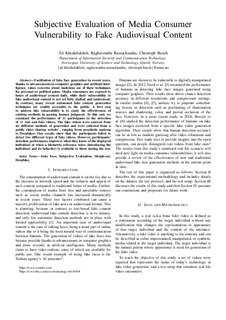| dc.contributor.author | Khodabakhsh, Ali | |
| dc.contributor.author | Ramachandra, Raghavendra | |
| dc.contributor.author | Busch, Christoph | |
| dc.date.accessioned | 2019-11-06T08:31:14Z | |
| dc.date.available | 2019-11-06T08:31:14Z | |
| dc.date.created | 2019-06-24T19:01:37Z | |
| dc.date.issued | 2019 | |
| dc.identifier.isbn | 978-1-5386-8211-1 | |
| dc.identifier.uri | http://hdl.handle.net/11250/2626787 | |
| dc.description.abstract | Facilitation of fake face generation in recent years, thanks to advancements in computer graphics and artificial intelligence, raises concerns about malicious use of these techniques for personal or political gains. Media consumers are exposed to hours of audiovisual content daily, while their vulnerability to fake audiovisual content is not yet fully studied and understood. In contrast, many recent automated fake content generation techniques are readily accessible to the public. A first step to address this vulnerability is to study the effectiveness of existing methods in passing human judgment. To this end, we examined the performance of 30 participants in the detection of 48 real and fake videos. The fake videos were sourced from six different methods of generation and were collected from a public video sharing website 1 , ranging from prosthetic makeup to Deepfakes. Our results show that the participants failed to detect two different types of fake videos. However, participants' detection performance improves when they know of the displayed individual or when a biometric reference video (introducing the individual and its behavior) is available to them during the test. | nb_NO |
| dc.language.iso | eng | nb_NO |
| dc.publisher | Institute of Electrical and Electronics Engineers (IEEE) | nb_NO |
| dc.relation.ispartof | Proceedings of the 11th International Conference on Quality of Multimedia Experience (QoMEX 2019) | |
| dc.title | Subjective Evaluation of Media Consumer Vulnerability to Fake Audiovisual Content | nb_NO |
| dc.type | Chapter | nb_NO |
| dc.description.version | acceptedVersion | nb_NO |
| dc.identifier.doi | 10.1109/QoMEX.2019.8743316 | |
| dc.identifier.cristin | 1707385 | |
| dc.description.localcode | © 2019 IEEE. Personal use of this material is permitted. Permission from IEEE must be obtained for all other uses, in any current or future media, including reprinting/republishing this material for advertising or promotional purposes, creating new collective works, for resale or redistribution to servers or lists, or reuse of any copyrighted component of this work in other works. | nb_NO |
| cristin.unitcode | 194,63,30,0 | |
| cristin.unitname | Institutt for informasjonssikkerhet og kommunikasjonsteknologi | |
| cristin.ispublished | true | |
| cristin.fulltext | preprint | |
| cristin.qualitycode | 1 | |
